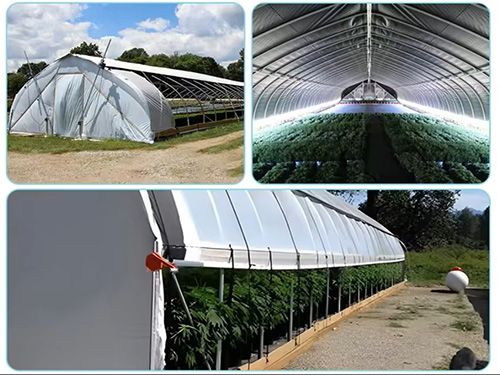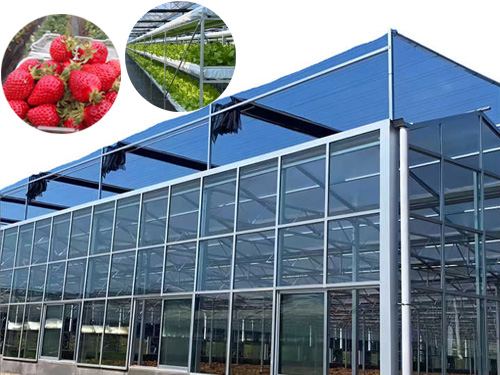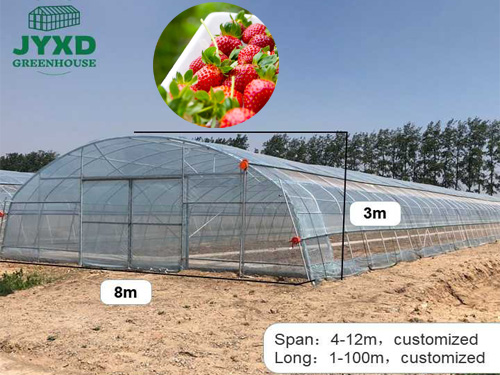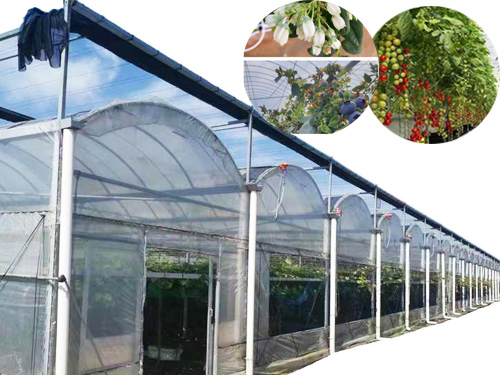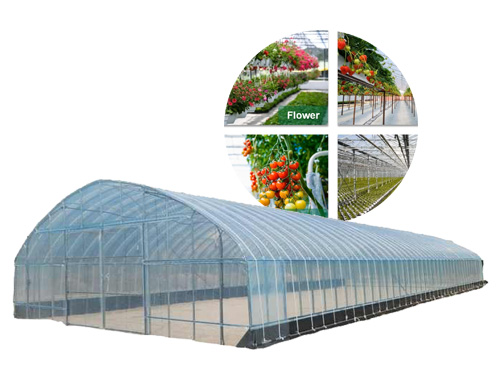NEWS DETAILS
NEWS INFORMATION
Effective Strategies for Preventing Scum Film in Greenhouse Water Systems: Tips for Cleaner and Healthier Plants
AUTHOR:jyxd-greenhouse DATE:2025-01-31 08:04:11 HITS:132
Water quality is crucial in greenhouse environments, as it directly impacts plant health, growth, and productivity. However, one common issue that greenhouse operators face is the formation of scum film in water systems. This scum can be caused by various factors, including the accumulation of organic matter, algae growth, and microbial buildup. Scum film can obstruct water flow, reduce nutrient availability, and even harbor harmful pathogens that affect plant health. In this article, we will explore effective strategies for preventing scum film in greenhouse water systems to maintain cleaner and healthier plants.
Understanding Scum Film and Its Impact on Greenhouse Water Systems
Scum film typically forms as a thin, floating layer on the surface of water, caused by organic debris, algae, and microorganisms. In greenhouse water systems, scum film can accumulate in reservoirs, pipes, irrigation lines, and water containers, leading to several negative effects:
· Reduced Water Flow: Scum can clog pipes, filters, and irrigation systems, obstructing the flow of water and nutrients to plants.
· Pathogen Growth: Stagnant water with scum buildup can create an environment for harmful bacteria, fungi, and algae to thrive, potentially spreading diseases to plants.
· Nutrient Imbalance: The presence of scum film can interfere with nutrient uptake by plants, as it can absorb essential nutrients in the water and create imbalances.
Preventing scum film is essential for maintaining an efficient and healthy greenhouse water system.
Strategies for Preventing Scum Film in Greenhouse Water Systems
There are several proactive strategies greenhouse operators can implement to prevent scum film formation and ensure clean, healthy water for plants. These methods focus on controlling the environment, improving water circulation, and managing organic matter buildup.
1. Maintain Proper Water Filtration Systems
Effective filtration is the first line of defense against scum buildup. Installing and maintaining high-quality filtration systems can help keep water free from organic debris, algae, and other particles that contribute to scum formation.
· Mechanical Filters: These filters physically remove debris from the water, preventing particles from accumulating and forming a scum layer. Regular cleaning and maintenance of mechanical filters are essential to ensure their effectiveness.
· Biological Filters: Biological filtration systems use beneficial bacteria to break down organic matter in the water. These systems help prevent the buildup of organic debris, which can contribute to scum formation.
· UV Sterilizers: Ultraviolet (UV) light sterilizers can be used to kill harmful microorganisms, such as algae and bacteria, that may contribute to scum film formation. UV sterilizers can be particularly effective in preventing algae growth in water systems.
By investing in and maintaining proper filtration systems, greenhouse operators can reduce the risk of scum film buildup and improve overall water quality.
2. Control Algae Growth with Chemical Treatments
Algae are a primary contributor to scum film in water systems. If left unchecked, algae can rapidly multiply, forming thick, green scum on the surface of the water. Chemical treatments can help control algae growth and prevent scum buildup.
· Algaecides: Algaecides are chemicals designed to kill or inhibit algae growth in water. These treatments can be added to water systems to prevent algae from forming scum layers. However, it is important to use algaecides carefully and follow manufacturer instructions to avoid harming plants or disrupting the water’s nutrient balance.
· Chelating Agents: Chelating agents can be used to bind to excess nutrients, particularly iron, which can fuel algae growth. By reducing the availability of nutrients that algae need to thrive, chelating agents can help keep algae growth under control.
While chemical treatments can be effective, they should be used in conjunction with other preventive measures to ensure long-term water quality management.
3. Enhance Water Circulation and Aeration
Stagnant water is more likely to develop scum film, as it provides an ideal environment for algae and organic matter to accumulate. Improving water circulation and aeration can help prevent scum buildup by keeping the water moving and oxygenated.
· Water Pumps: Installing water pumps to circulate water throughout the system can prevent stagnation and reduce the chances of scum formation. Proper circulation ensures that debris and organic matter do not settle at the water’s surface.
· Aeration Systems: Aeration systems, such as air stones or diffusers, can introduce oxygen into the water. This promotes the growth of beneficial bacteria that break down organic matter, preventing it from contributing to scum formation.
· Waterfall Features: Adding waterfall features or similar water movement structures can help keep the water moving and discourage scum buildup. These features can also improve oxygen levels and create a more dynamic water environment.
By ensuring proper water circulation and aeration, greenhouse operators can maintain a healthier water system and reduce the likelihood of scum formation.
4. Regularly Clean and Maintain Water Tanks and Pipes
Routine cleaning and maintenance of water tanks, pipes, and irrigation lines are crucial for preventing scum buildup. Organic debris, such as leaves and plant matter, can accumulate in these systems and contribute to scum formation over time.
· Clean Water Tanks: Periodically draining and cleaning water tanks helps to remove any organic matter or algae that may have accumulated. Using non-toxic cleaning agents can ensure the tanks are sanitized without harming plants or water quality.
· Flush Pipes and Irrigation Lines: Over time, pipes and irrigation lines can become clogged with organic matter or scum. Flushing these systems regularly helps to prevent blockages and maintain smooth water flow.
· Check for Leaks and Stagnant Areas: Leaks and stagnant areas in water systems can create pockets of water where debris and algae can accumulate. Regularly inspect the water system for leaks or areas with low water flow and address them promptly.
Regular cleaning and maintenance ensure that the water system remains efficient and free from scum buildup.
5. Reduce Organic Matter and Nutrient Overload
Excessive organic matter and nutrient overload can contribute to scum film formation by providing food for algae and bacteria. Proper nutrient management and waste removal are key to keeping water clean and preventing scum buildup.
· Limit Fertilizer Use: Overuse of fertilizers can result in nutrient-rich water that encourages algae growth. Use fertilizers according to the specific needs of the plants, and avoid over-fertilizing to reduce nutrient levels in the water.
· Remove Plant Debris: Regularly removing dead leaves, plant roots, and other organic debris from the water system helps to reduce the amount of material available for microbial growth. This helps to keep water cleaner and reduce the risk of scum film formation.
· Maintain Proper pH Levels: Algae thrive in certain pH conditions. Regularly monitoring and adjusting the pH levels of the water can help prevent conditions that encourage algae growth. Ideally, greenhouse water should have a neutral pH to support healthy plant growth and discourage scum formation.
By carefully managing organic matter and nutrient levels, greenhouse operators can create an environment that is less conducive to scum buildup.
Conclusion
Preventing scum film in greenhouse water systems is essential for maintaining a clean, efficient, and healthy environment for plants. By implementing strategies such as proper filtration, controlling algae growth, enhancing water circulation, regular maintenance, and managing nutrient levels, greenhouse operators can reduce the risk of scum formation and ensure that their water systems remain free from harmful buildup. Cleaner water systems not only improve water flow and nutrient availability but also promote healthier plants and higher yields. By taking a proactive approach to water management, greenhouse operators can maintain optimal growing conditions and support the long-term success of their crops.
Hebei Juyou Xinda Greenhouse Facilities Co.,Ltd.
Copyright © 2024-2025 https://www.jyxd-greenhouse.com. All Rights Reserved Hebei Juyou Xinda Greenhouse Facilities Co.,Ltd.Copyright





 Current Location:
Current Location:


